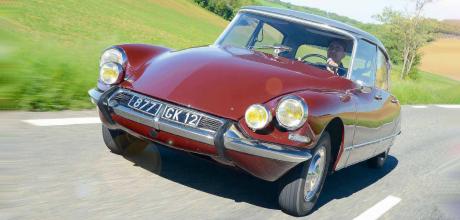1967 Citroën DS21 Pallas
«At a time when everyone fantasized about seeing a car fly over the earth, the most innovative of French manufacturers created the DS, a prototype halfway between a flying saucer and a car, but available for purchase on the market. Well, do you know what? Some even saw it fly… in the movies.
Text by Hugues Chaussin
Photos from Gazoline Archives, Stéphane Guitard, and H.C.

It's a marvel to behold, a marvel to drive, a marvel to be driven in: the one that amazed with its speed, its design, and its comfort from the day of its release has become the Holy Grail for „DS enthusiasts.“ Here is the 1967 DS 21 Pallas.
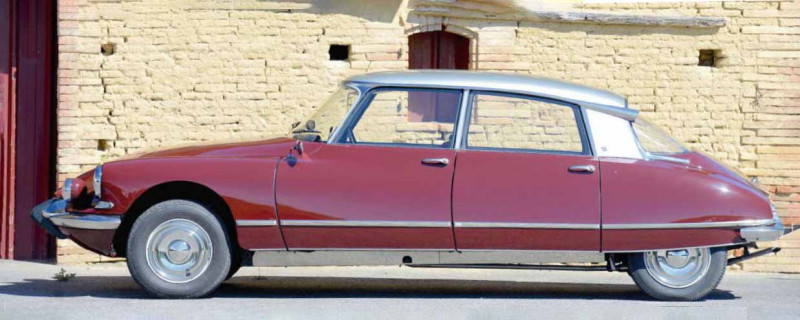
How can one be insensitive to the charm of a DS? In our editorial office, we don't hide our fondness for this fantastic car. Everyone, of course, has their preferences, and for me, the most fascinating is the one you have in front of you, the first 21 with the Pallas trim, an exclusive car due to the richness and quality of its equipment, but one that doesn't pretend to move forward slowly.
This beautiful AC 421 Bordeaux DS with a silver gray roof belongs to Olivier Estibals, also known as Docteur Estipallas, a friendly collector with a strong penchant for French cars. His treasure left the Javel factory on July 18, 1967, making it, for the record, one of the last 300 DS with the original „nose“...
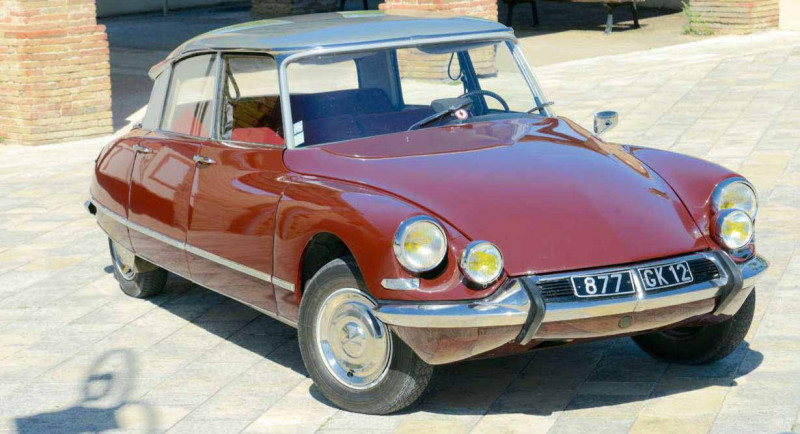
which is actually the second if you take the time to observe these vehicles carefully! Olivier has arranged a meeting in the hideout he shares with his brother Bruno in Occitanie. They live their passion 100%, together, since their teenage years. They each have their own cars and gladly lend them to each other, although some change hands very rarely. That's the case with „our“ DS, about which Bruno doesn't hesitate to say, „It's his mistress.
Having owned and loved it for 30 years, Olivier knows it by heart. So, seeing my amazement when I discover the interior, he can't resist listing the important details. The sum of little things that make a DS unlike any other car. “The indication of braking distance on dry ground is specific to DS 21. The brake pedal is located lower than the accelerator so that the driver only has to push down the foot to brake.» Then, to illustrate his point about the luxurious interior of the Pallas, Olivier invites me to the back of the garage where a 1966 DS 19 Confort is parked. As soon as he opens the driver's door, I understand. It's like we are transitioning from a cozy house to a richly furnished Haussmannian apartment.
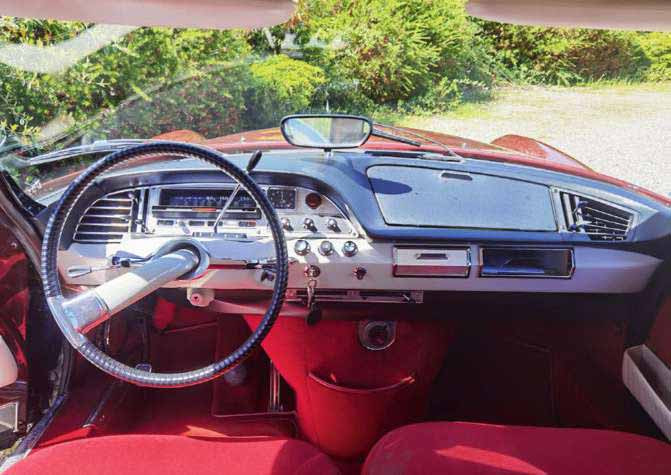
What class, the Pallas! While I still have stars in my eyes, Olivier suggests that I leave my place in the Citroën to look under the hood. While the engine is relatively simple, there are many elements that intrigue me underneath. Starting with the headlamp adjustment device linked to the vehicle's height, a privilege of the DS 21, which Olivier explains to me is «purely mechanical, using piano wire connected to the rear stabilizer bar.» Then, he details the components specific to the DS, such as the hydro box equipped with a centrifugal regulator and a clutch corrector controlled by the throttle opening.
Next, he points out the hydraulic block, the «brain» of the system, which activates gear changes. The examination concludes with a color that is ubiquitous under the hood of this 1967 car: green. It was from the second half of the previous year (officially at the Salon) that the DS switched from synthetic red liquid to green, mineral liquid.
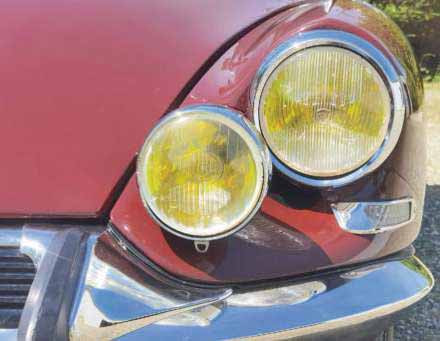
Back inside, where my host forgot to show me a detail. After lifting a corner of the carpet, he explains that this model has, unlike the ID, three centimeters of Dunlopillo on top of the floor.
The same remark about the thick seal applied under the rear trunk lid. Since we are back inside, let's stay there where we are so comfortably seated on the Rhovyline seats."
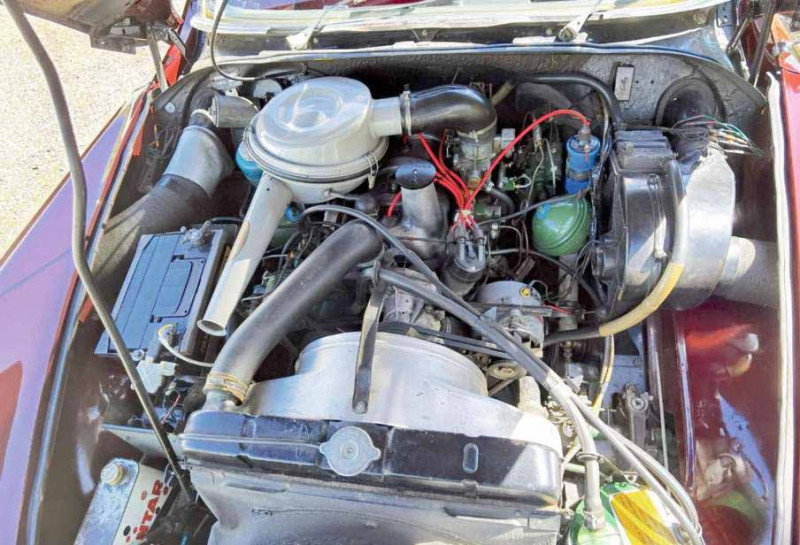
The harmony of Cornaline red and white is a success. Very Latin, this combination reminds of Alfa Romeo, right down to the attention to detail in the assembly and the quality of materials. These DS cars were truly well-crafted. While I explore everything with my eyes, the owner starts the engine by manipulating the gear lever, which also acts as the starter. The sound emitted by the engine isn't particularly impressive, so my attention wanders elsewhere once again. Specifically, the work of the suspension fascinates me. Its subtle squeaks and the movements it transmits to the car are like a signature. By magic, the DS «rises» with a noise of a rolling saucer, indicating to its driver that it's ready to take flight. Olivier sets off first to show me how the car works. I've driven them before, but the refresher course from the DS expert proves useful. I appreciate the serenity provided by this car, which is certainly not like any other. Not surprisingly, the comfort is royal, even better than in a modern car with ultra-low tires. The excellent Michelin XAS tires, inseparable from a DS, contribute to this, although the main reason, of course, lies with the famous green-painted device. The only thing that might bother the occupants is the body roll of another era.
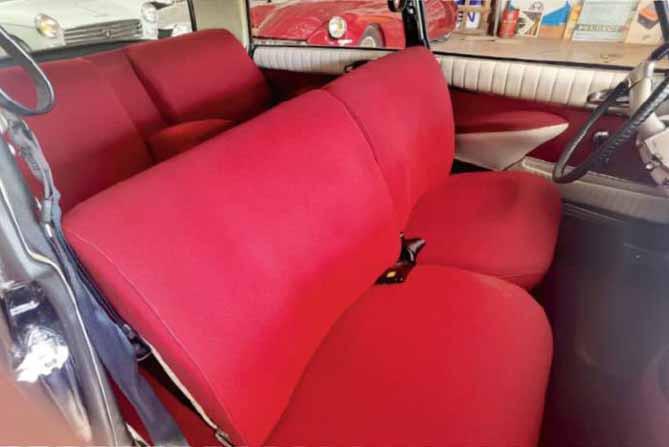
After the static photo session, Olivier hands me the steering wheel. Following the customary instructions, I engage the first gear, and we're off. The start is peaceful as I need to get used to the handling of the gearshift, which initially feels a bit abrupt. However, this gearbox is a delight. The gears engage without needing to disengage the clutch – in fact, there isn't even a clutch pedal – which reminds me somewhat of the Cotal gearbox in terms of the benefits it provides. Throughout this test, I tried, following my instructor's advice, to progress in using this intuitive system that requires getting accustomed to it. The most subtle part is knowing how to use the accelerator pedal to achieve perfect driving fluidity. The engine is eager and benefits from a well-distributed torque range, allowing for rapid acceleration. However, it lacks the punch to win the race at every green light. The DS 21 is far from having the liveliness of a Renault 8 Gordini. On the other hand, once it's in fourth gear, the 2,175 cm3 engine allows for excellent accelerations. Overtaking with it is a formality, without even needing to downshift. And when the left curve appears at the end of the straight line, the skillful driver doesn't even have to lift off the gas. Leaning firmly on its outside front wheel, the Citroën takes on the challenge with authority. In this regard, the Gordini seems far less composed. Each one excels in its own domain!

As I become more comfortable, the desire to go faster through curves becomes evident. Seeing my caution, Olivier encourages me generously, well aware of how his car is calibrated to run at high speeds with a high level of safety. In 1967, what car could keep up with a DS? Excluding a few very powerful Grand Touring cars, I'm still searching. What other car could stop as promptly as this one? At the wheel, there is no need or desire to step hard on the brake pedal to achieve a sharp, almost violent slowdown, much more energetic than what most brakes of that era could offer. Driving the DS reveals its extraordinary potential combined with a sense of serenity, allowing us to understand, 68 years after its release in 1955, why it revolutionized the automotive world. But also why, when it was retired two decades later, it was still relevant. Many said it was 20 years ahead of its time. Once again, I am convinced they were right.
Our sincerest thanks to Olivier and Bruno Estibals, as well as their parents and children, for their hospitality. Special mention to Patrice Vergès, who led us to Olivier and his beautiful DS.
Technical Data 1967 Citroën DS21 Pallas
ENGINE
- Longitudinally mounted front 4-cylinder engine, cast iron block, alloy cylinder head, one side camshaft driven by a chain, two overhead valves (in a 60° V) per cylinder operated by rocker arms, spring-loaded, five-bearing crankshaft, antifriction with thin bearings, pressure lubrication by mechanical gear pump
- Displacement: 2,175 cm3
- Bore x Stroke: 90 x 85.5 mm
- Maximum power: 109 hp SAE at 5,500 rpm
- Maximum torque: 17.7 mkg SAE at 3,000 rpm
- Compression ratio: 8.75:1
- Fuel supply: one Weber 28/36 DDE double-barrel inverted carburetor
- Electrical system: 12V 40 Ah battery, coil, and distributor, 400W dynamo
- Cooling: liquid with thermostat.
TRANSMISSION
- Front-wheel drive with homokinetic joints (tripod joints at the gearbox output + double joints at the wheels)
- Clutch: dry single-disc with automatic hydraulic control
- Gearbox: 4-speed synchronized + Reverse, hydraulic gear lever above the steering column (or mechanical gearbox with right-side steering column control)
- Gear ratios: 1st: 0.308 – 2nd: 0.515 – 3rd: 0.786 – 4th: 1.174 – Reverse: 0.317
- Final drive ratio: 8x35.
STRUCTURE
- 5-seater sedan, steel platform on which a structure receiving steel, aluminum, and synthetic fiber body elements is bolted
- Front suspension: independent wheels with superimposed swing arms and stabilizer bar
- Rear suspension: independent wheels with trailing arms and stabilizer bar, hydraulic system comprising a sphere per wheel with built-in shock absorber and front/rear ride height corrector (green mineral liquid)
- Wheels: 15-inch steel
- Tires: Michelin XAS 180 x 15 (Front) and 155 x 15 (Rear)
- Brakes: inboard front discs/rear drums with high-pressure hydraulic assist
- Handbrake: mechanical on the front wheels
- Steering: power-assisted rack and pinion
- Turning radius: 5.50 meters
- Dimensions (L x W x H): 4.84 x 1.79 x 1.47 m
- Wheelbase: 3.125 m
- Front/Rear track: 1.50/1.30 m
- Weight: 1,295 kg unladen.
PERFORMANCE
- Top speed: 175 km/h
- 0-400 meters: 36 seconds
- Fuel consumption: 12 l/100 km on average.
PRODUCTION
- 21,668 DS 21 with hydro box and 7,629 DS 21 with mechanical box produced during the 1967 model year (09/1966 to 07/1967)
- Price 1967 (1966 Salon): 17,135 F (for comparison, Renault 16 Super: 10,740 F, Simca 1501 GLS: 11,550 F, Peugeot 404 Injection Super Luxe: 12,900 F, DS 21 (Confort): 15,650 F, DS 21 DS 21 Pallas 1967 Technical Details:
- Price 1967 (1966 Salon):
- DS 21 Confort: 15,650 F
- DS 21 Berline Prestige: 18,585 F
- BMW 2000 Ti: 21,500 F
- Color Options 1967:
- Monte Carlo blue
- Carrara white
- Kandahar gray
- Bordeaux
- Palladium gray
- Interior Options:
- Fabric Jersey in blue, old gold, gray, red, or green Jura
- Natural or black leather
- Additional Options:
- Simplex anti-theft system
- Autoradio and hi-fi system
- Twin compressor horns
- "-20°" heating
- Right air blower
- Adjustable front seats
- Fabric or leather headrests (if leather seats)
- Fabric or leather central armrest (if leather seats)
- Leather upholstery
- Front seat belts
- Front and rear seat belts
- Type Mines: DS 21
- Fiscal power: 12 CV
The engine of the DS 21 is a development of the DS 19's four-cylinder, itself extrapolated from the Traction Avant's block.
Overtaking with a DS 21 is a formality, without even needing to downshift.
The mechanical headlight height adjustment system linked to the inclination of the body is connected to the rear stabilizer bar.
If one detail were to sum up the rich presentation of a DS 21 Pallas, the door trim would be ideal. The combination of chrome touches, quilted off-white vinyl, and Cornaline red Rhovyline is majestic.
Identification:
Hull plate: riveted vertically under the manufacturer's plate.
Engine reference: aluminum plate located on the left side of the engine block.
Paint reference: aluminum plate riveted on the hood sheet metal, near the right hood hinge.
Cold stamping: placed on the hood sheet metal, passenger side (concealed under the seal).
Manufacturer's plate: positioned on the hood sheet metal, passenger side (under the cold stamping).
The famous pedal arrangement of a DS with a hydro box: on the left, the «foot-operated handbrake,» in the middle, the brake mushroom, and on the right, the accelerator pedal.
The Rhovyline red upholstery, both sober and very comfortable, invites long journeys in absolute serenity.
The DS 21 Pallas, draped in Bordeaux red and topped with silver-gray, has a stunning allure! The orange stoplights are specific to the DS 21, while the side bands encompassing the reflectors make it recognizable as a Pallas at first glance.
The comfort is royal, better than in a modern car with ultra-low tires.
The adoption of new brakes on the DS in 1967 led to a modification of the lower panel, which now features two air inlets in addition to the large grille required for engine cooling. Let's not forget that these cars lack a grille...
Each version and finish of the DS/ID has distinct side panel embellishments. The Pallas features these brushed stainless steel plates. The side indicator cones and rear trunk lid hinges also vary depending on the model and year.
The gear lever of the DS with a hydro box emerges above the steering column. The «D» visible on the grille indicates «Démarreur» (Starter): to start the car, you need to push the lever to the left after turning the key. The stopping distance indicator based on speed (80 m at 100 km/h, etc.) is specific to the DS 21.


